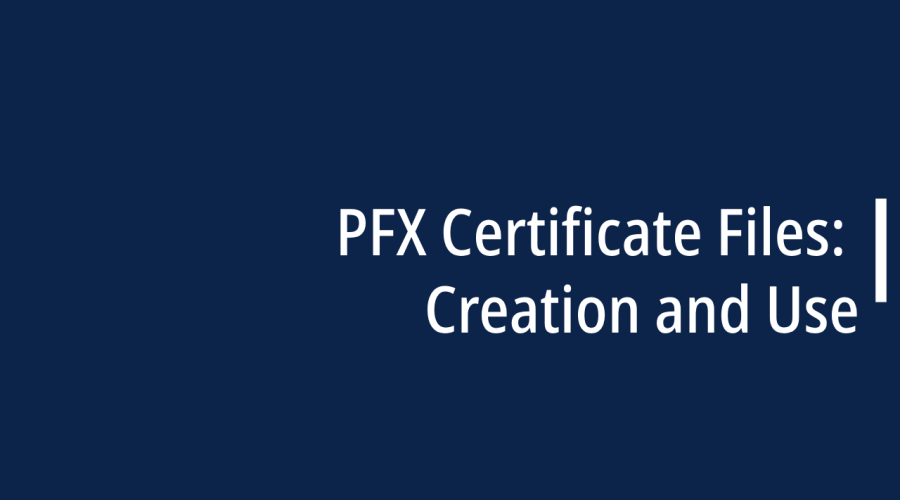A PFX certificate file, also known as a Personal Information Exchange file, is a binary format used to store a private key, public key, and the associated digital certificate in a single file. These files are commonly used for securing communications, encrypting data, and authenticating users or services in various digital environments.
Why PFX Certificates Matter in Digital Security
PFX certificates play a vital role in digital security for several reasons:
Secure Communication: They enable secure communication between parties by encrypting data and verifying the authenticity of the parties involved.
Data Protection: PFX certificates help protect sensitive data from unauthorized access or tampering.
User Authentication: They authenticate users or services, ensuring that only authorized entities can access specific resources.
Compliance: Many regulatory requirements and industry standards mandate the use of PFX certificates to ensure data privacy and security.
How to Create PFX File: Step-by-Step Guide
Creating a PFX (Personal Information Exchange) certificate file typically involves generating a private key and a public key certificate, and then combining them into a single PFX file. This file format is commonly used for securing web applications, encrypting email, and more. Here’s a step-by-step guide on how to create a PFX certificate file:
Note: This guide assumes you have access to a certificate authority (CA) or have the tools necessary to generate a self-signed certificate. If you’re using a CA, the process may vary depending on the CA service you’re using.
Step 1: Generate a Private Key and a Certificate Signing Request (CSR)
Open a command prompt or terminal window.
Use a tool like OpenSSL to generate a private key and a CSR. Here’s an example command to generate a private key and a CSR:
openssl req -newkey rsa:2048 -nodes -keyout yourdomain.key -out yourdomain.csr
Replace yourdomain.key with the name you want for your private key and yourdomain.csr with the name you want for your CSR. Follow the prompts to provide information about your organization, common name (usually the domain name), and other details.
Step 2: Submit the CSR to a Certificate Authority (CA) (Optional)
If you’re using a public CA, submit the CSR to the CA, and they will provide you with a certificate.
Step 3: Combine the Private Key and Certificate into a PFX File
Once you have the certificate from the CA or if you’re using a self-signed certificate, you can combine the private key and certificate into a PFX file using OpenSSL:
openssl pkcs12 -export -out yourdomain.pfx -inkey yourdomain.key -in yourdomain.crt
yourdomain.pfx: The name you want for your PFX file.
yourdomain.key: The private key file generated in Step 1.
yourdomain.crt: The certificate file obtained from the CA or generated in Step 1 (if self-signed).
You will be prompted to set a password for the PFX file. This password will be required when importing the PFX into applications or servers.
Step 4: Securely Store the PFX File
The PFX file contains both the private key and the certificate, so it must be kept secure. Store it in a safe location with restricted access.
Step 5: Import the PFX Certificate
Depending on your use case, you may need to import the PFX certificate into various applications or servers. The process for importing can vary significantly depending on the application or server you are using. Here are some common scenarios:
IIS (Internet Information Services): In Windows Server, you can use the IIS Manager to import the PFX certificate.
Apache: Configure your Apache web server to use the PFX certificate.
Java Keystore: If you are using Java applications, you may need to import the PFX certificate into a Java keystore using the keytool command.
Remember to follow the specific documentation for the application or server you’re using to import the PFX certificate correctly.
Best Practices for PFX Certificate Management
- SEO Keywords: PFX certificate management best practices, Tips for handling PFX certificates
- To maximize the benefits of PFX certificates, consider these best practices:
- Keep PFX Files Secure: Store PFX files in a highly secure location, ideally offline, and restrict access to authorized personnel.
- Regularly Renew Certificates: Stay proactive by renewing certificates before they expire to avoid service disruptions.
- Implement Certificate Revocation Checks: Regularly check certificate revocation status to ensure you are not using compromised certificates.
- Document Certificate Details: Maintain detailed records of certificates, including expiration dates, issuance dates, and purposes.
- Use Strong Passwords: Set strong passwords for PFX files to protect private keys.
Conclusion: Elevating Digital Security with PFX Certificates
PFX certificate files are integral to digital security, enabling secure communication, data protection, and user authentication. Understanding their importance and knowing how to create and manage them is essential for safeguarding sensitive information in today’s digital world. By following best practices and staying informed about cybersecurity trends and statistics, organizations can strengthen their security posture and protect against evolving threats.

Gloria Bradford is a renowned expert in the field of encryption, widely recognized for her pioneering work in safeguarding digital information and communication. With a career spanning over two decades, she has played a pivotal role in shaping the landscape of cybersecurity and data protection.
Throughout her illustrious career, Gloria has occupied key roles in both private industry and government agencies. Her expertise has been instrumental in developing state-of-the-art encryption and code signing technologies that have fortified digital fortresses against the relentless tide of cyber threats.
